Introduction to microfluidic cell sorting and separation
 |
Review done thanks to the support of the LAPASO project
FP7-PEOPLE-2013-ITN – Marie-Curie Action: “Innovative Training Networks” Written by Walter Minnella, PhD student : walter.minnella@elvesys.com |
 |
Some standard techniques have been developed for cell separation and sorting. These techniques often require intensive tasks and multiple additional “tags” or “labels” to identify cells of interest.
Recently, new methods have been developed which avoid the use of biochemical labels. Label-free cell sorting techniques use intrinsic physical biomarkers to separate and sort the cells. This means that the separation force is only dependent on differences in an intrinsic physical property of the cells.
Microfluidic systems can integrate various sorting methods based on physical parameters of cells. The scale of microfluidic systems provides a perfect interface for the manipulation of single cells and access these forces in a variety of ways. They also may reduce reagent volume and cost and are potentially portable. For these reasons, microfluidic techniques are good candidates for the future high throughput sorting systems for cells.
In this review we will describe some label-free microfluidic techniques to accomplish cell separation and sorting. For further information we recommend referring to the interesting review from Gossett et al., Anal Chem 2010 [1].
Figure from Gossett & al. Anal Chem 2010
A Pilot Pack has been assembled to perform label-free cell sorting using Elveflow microfluidic instruments.
1. Microfluidic filters for cell separation and sorting
Microfluidic or microscale filters are simple methods for separating cells based on size or deformability as biomarkers. These techniques allow you to precisely adjust the filter pore size to the required needs [2]. However these filters face many challenges including heterogeneity of cell sizes within a population, clogging and fouling.
Schematic illustration for weir, pillar and cross-flow microfluidic filters. From Gossett et al. Anal Bioanal Chem 2010.
2. Hydrodynamic microfluidic separation and sorting technique
This technique presumes that at a low Reynolds number (as it happens in the microfluidic scale) the center of a particle will follow fluid streamlines. By partitioning the flow in a clever way (controlling flow rate through one or more inlets, channel geometry, and configuration of outlets) several methods make possible to dictate size-based cell separation and sorting [3].
Hydrodynamic methods of separation. A) Pinched flow microfluidic fractionation. From Takagi et at. Lab Chip 2005. B) Hydrodynamic microfluidic filtration. From Yamada et al. Lab Chip 2005.
3. DLD separation and sorting (Deterministic Lateral Displacement)
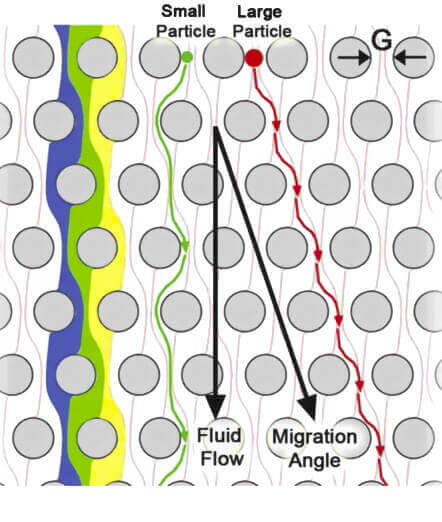 Deterministic lateral displacement (DLD) technique. From Inglis DW. Appl Phys Lett 2009.
Deterministic lateral displacement (DLD) technique. From Inglis DW. Appl Phys Lett 2009.
Deterministic Lateral Displacement (DLD) is a size-based cell sorting technique which consists in an ordered array of obstacles (micropost array). The laminar flow together with interactions with the array, forces particles or cells into specific trajectories through the device. The displacement of cells or particles perpendicular to primary flow is determined by the pattern of the array [4].
– Particles or cells below a critical size follow streamlines through the array gaps with no net displacement from the original streamline.
– Particles above the critical size are displaced laterally to cross sequential streamlines with each row traveling at an angle predetermined by the post offset distance.
The critical particle size for fractionation depends on the gap between posts and offset of posts [5].
4. Microfluidic field-flow fractionation separation and sorting
With field-flow fractionation (FFF) techniques, a separation field (flow, electric, gravitational, centrifugal, etc.) is used to produce a force in a perpendicular direction from the primary channel flow. Inside a microfluidic device, with its characteristic parabolic velocity profile, particles that feel the greatest force are driven closest to the wall where flow velocity is lower. In contrast, particles feeling a weaker perpendicular force remain in the center where the flow velocity is faster [6]. As a result some particles are transported faster along the channel than others and are eluted before.
Field-flow fractionation microfluidic technique. From Wikipedia 2007.
5. Microfluidic microstructures: grooves, chevrons, herringbones and hydrophoresis
Certain geometries of microstructure protrusions in microfluidic channels allow size-, deformability- and density-based cell and particle separations. Protrusions geometry can perform binary separation of particles of different sizes and concentration or focusing on all particulate matter to a single stream. [7].
Example of a microfluidic microstructure mechanism for particle separation. From Choi et al. Lab Chip 2010.
6. Microfluidic inertial separation and sorting techniques
A cell size sorting Pilot Pack has been assembled based on inertial separation. This technique relies on a combination of an asymmetrical sheath flow and proper channel geometry to generate a soft inertial force on the sample fluid in the curved and focused sample flow segment to deflect larger particles away while the smaller ones are kept on or near the original flow streamline.
The working principle of this separation is to devoid of filter interfaces or external force fields, avoiding clogging and making it easy to setup. Balanced transverse force components concentrate and divert particle streams according to the designed size cutoff. This spiral flow filtration concept can address size and mass-based separation of microparticles, including biological agents [8]. This method can be applied for passive sperm sorting and selection.
Example of an inertial microfluidic technique. From Seo et al. Appl Phys Lett 2007.
[starter_pack_rebound]
7. Gravity and sedimentation microfluidic separation and sorting technique
In this cell separation and sorting technique, gravity acts perpendicular to channel flow, and particles sediment at a velocity dependent on their radius, the acceleration of gravity, the difference between the density of the particles and the density of the fluid, and the viscosity of the fluid.
Separation of particles with different radii is amplified by hydrodynamic effects: the channel of the microfluidic device gradually widens asymmetrically such that the flow near the bottom of the channel is angled downward, assisting in the migration of larger radius particles [9].
Gravitational and sedimentation microfluidic technique. From Huh et al. Anal Chem 2007.
8. Microfluidic biomimetic separation and sorting technique
In order to achieve desired fractionation of blood components, Biomimetic microfluidic separation techniques emulate hemodynamic phenomena involving the intrinsic properties of blood and the microvasculature. These phenomena have been observed and replicated in microfluidic systems and include leukocyte margination, plasma skimming, and the bifurcation law, also known as Zweifach–Fung effect.
A number of techniques have been developed to take advantage of these effects [10] [11].
Example of two microfluidic devices that mimic the microvasculature. a) Leukocyte margination is used to isolate leukocytes (*) as they are typically found in the near-wall regions of flow. From Shevkoplyas et al. Anal Chem 2005. b) Bifurcation law is manipulated to remove cell-free plasma from blood. From Yang et al. Lab Chip 2006.
9. Microfluidic magnetophoresis separation and sorting technique
Magnetophoresis separation and sorting technique is a microfluidic system which exploits the intrinsic magnetophoretic properties of blood cells for separation. For example, white blood cells are diamagnetic whereas red blood cells can be paramagnetic, allowing to sort them efficiently with a magnetic field[12].
Magnetophoresis microfluidic technique. In this example a continuous flow gravity-driven microfluidic system is proposed for separation of WBCs and deoxygenated RBCs that uses an array of soft-magnetic elements which are magnetized by a bias field. In this model WBCs behave as diamagnetic micro-particles and deoxygenated RBCs are paramagnetic. Therefore, they move in opposite directions perpendicular to primary flow. From Furlani EP. J Phys D Appl Phys 2007.
10. Aqueous two-phase systems (ATPS) for cell separation and sorting
This technique is based on the differential affinity of cells and particles for either of two immiscible polymers (usually polyethylene glycol (PEG) or dextran) or their interface. Separation criteria include surface properties and net charge [13].
Schematic illustration of leukocyte separation based on microfluidic aqueous two-phase system (ATPS). In this example, whole blood diluted in PEG is exposed to a PEG-Dex interface, represented by the dashed line. Due to differences in surface energies, the leukocytes prefer the interface while RBCs migrate into the Dex region. From SooHoo et al. Biomed microdevices 2009.
11. Acoustophoresis cell separation and sorting technique
Acoustic cell separation and sorting techniques rely on the fact that cells and particles suspended in fluid experience an acoustic radiation force when they are exposed to ultrasound. Separation of particles utilizing this force can be achieved by generating a standing wave over the cross section of a microfluidic channel.
In this example configuration, while the fluid flow carries particles through the channel, a radiation force pushes them towards either the pressure nodes or the pressure antinodes of the standing wave [14] [15].
Acoustic separation. The acoustic radiation force may be manipulated for density-based, equilibrium separation (a, b) From Laurell et al. Chem Soc Rev 2007. or size-based kinetic separation (c). From Petersson et al. Anal Chem 2007.
12. Dielectrophoresis (DEP) cell separation and sorting technique
Dielectrophoresis (DEP) cell separation and sorting technique relies on the principle that when polarizable molecules such as large biomolecules and cells are placed in a non-uniform electric field, the field can impart a net force on the particle due to an induced or permanent dipole. This force does not require the particle to be charged. All particles exhibit dielectrophoretic activity in the presence of electric fields. However, the strength of the force strongly depends on the medium and particles electrical properties, on the particles’ shape and size, as well as on the frequency of the electric field. Consequently, fields of a particular frequency can manipulate particles with great selectivity.
DEP has been applied in a number of systems based on selective particle trapping and elution or deflection in continuous flow.[16]
Dielectrophoretic (DEP) separation can be a) positive (pDEP) or b) negative (nDEP) which affects where the cells are positioned within a field. c) DEP has been utilized in microfluidic systems in a variety of arrangements, some of which are depicted here. From Gossett et al. Anal Bioanal Chem 2010.
Conclusion
This review on label-free microfluidic cell separation and sorting techniques underscores the growing importance of non-invasive, efficient cell sorting in advancing biomedical and cell biology research. Label-free microfluidics, particularly through methods like acoustic, inertial, and optical-based sorting, is increasingly recognized for its ability to maintain cell integrity without labeling, providing a more natural approach to cell analysis. Techniques leveraging laminar flow in microfluidic channels enable high precision and control over cell behavior and distribution, essential for applications in diagnostics, personalized medicine, and research.
Elveflow, with its cutting-edge expertise in microfluidics, stands out as an ideal scientific partner, providing advanced tools and support to optimize a wide range of experiments. Our microfluidic devices are specifically designed to harness laminar flow properties, making complex separations and sorting tasks more accessible and efficient for researchers across disciplines. With ongoing innovation, Elveflow continues to drive progress in label-free cell manipulation, positioning itself at the forefront of technology development in microfluidics.
References
- Gossett DR, Weaver WM, Mach AJ, Hur SC, Tse HT, Lee W, Amini H, Di Carlo D.(2010) Label-free cell separation and sorting in microfluidic systems. Anal Bioanal Chem 397:3249
- Ji H, Samper V, Chen Y, Heng C, Lim T, Yobas L (2008) Silicon-based microfilters for whole blood cell separation. Biomed Microdevices 10:251–257
- Yamada M, Nakashima M, Seki M (2004) Pinched flow fractionation: continuous size separation of particles utilizing a laminar flow profile in a pinched microchannel. Anal Chem 76:5465–5471
- Huang LR, Cox EC, Austin RH, Sturm JC (2004) Continuous particle separation through deterministic lateral displacement. Science 304:987–990
- Inglis DW, Davis JA, Austin RH, Sturm JC (2006) Critical particle size for fractionation by deterministic lateral displacement. Lab Chip 6:655–658
- Giddings JC (1993) Field-flow fractionation: analysis of macromolecular, colloidal, and particulate materials. Science 260:1456–1465
- Choi S, Park J (2007) Continuous hydrophoretic separation and sizing of microparticles using slanted obstacles in a microchannel. Lab Chip 7:890–897
- Seo J, Lean MH, Kole A (2007) Membrane-free microfiltration by asymmetric inertial migration. Appl Phys Lett 91:033901– 033903
- Huh D, Bahng JH, Ling Y, Wei H, Kripfgans OD, Fowlkes JB, Grotberg JB, Takayama S (2007) Gravity-driven microfluidic particle sorting device with hydrodynamic separation amplification. Anal Chem 79:1369–1376
- Shevkoplyas SS, Yoshida T, Munn LL, Bitensky MW (2005) Biomimetic autoseparation of leukocytes from whole blood in a microfluidic device. Anal Chem 77:933–937
- Yang S, Undar A, Zahn JD (2006) A microfluidic device for continuous, real time blood plasma separation. Lab Chip 6:871
- Furlani EP (2007) Magnetophoretic separation of blood cells at the microscale. J Phys D Appl Phys 40:1313–1319
- SooHoo J, Walker G (2009) Microfluidic aqueous two phase system for leukocyte concentration from whole blood. Biomed Microdevices 11:323–329
- Laurell T, Petersson F, Nilsson A (2007) Chip integrated strategies for acoustic separation and manipulation of cells and particles. Chem Soc Rev 36:492–506
- Petersson F, Aberg L, Sward-Nilsson A, Laurell T (2007) Free flow acoustophoresis: microfluidic-based mode of particle and cell separation. Anal Chem 79:5117–5123
- Vahey MD, Voldman J (2008) An equilibrium method for continuous-flow cell sorting using dielectrophoresis. Anal Chem 80:3135–3143
For more reviews about microfluidics, please visit our other reviews here: «Microfluidics reviews». The photos in this article come from the Elveflow® data bank, Wikipedia or elsewhere if precised.

Microfluidics knowledge
Do you want tips on how to best set up your microfluidic experiment? Do you need inspiration or a different angle to take on your specific problem? Well, we probably have an application note just for you, feel free to check them out!
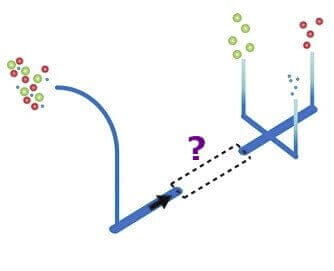

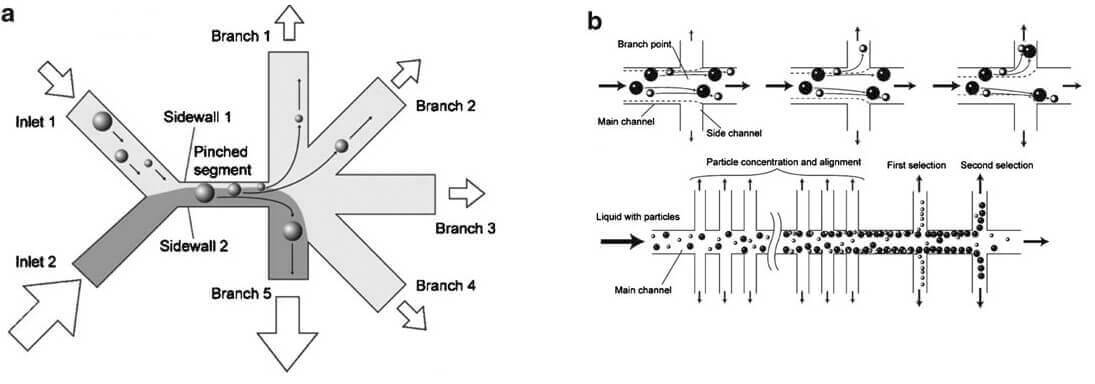

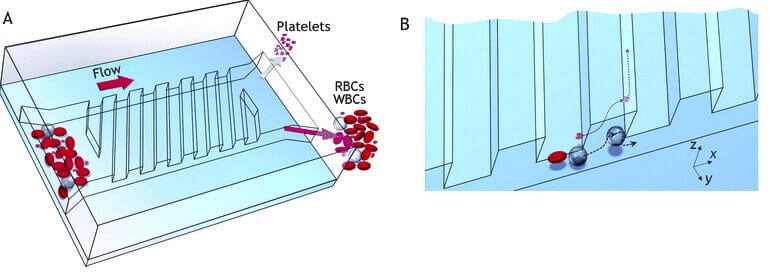
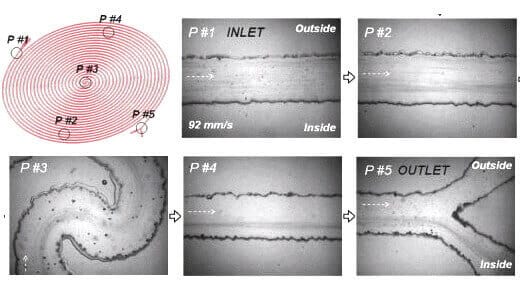
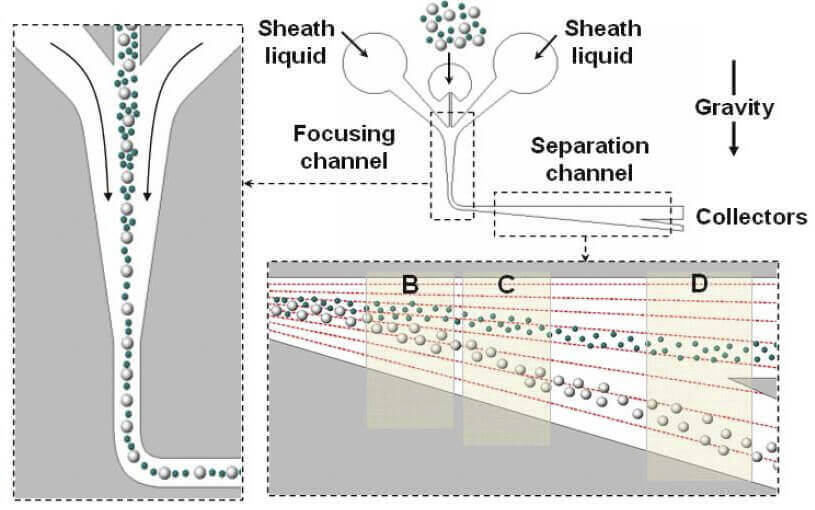
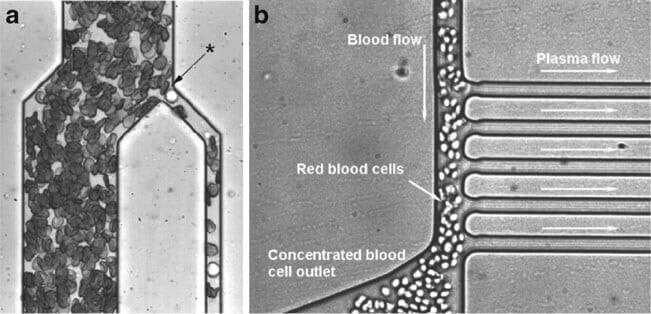
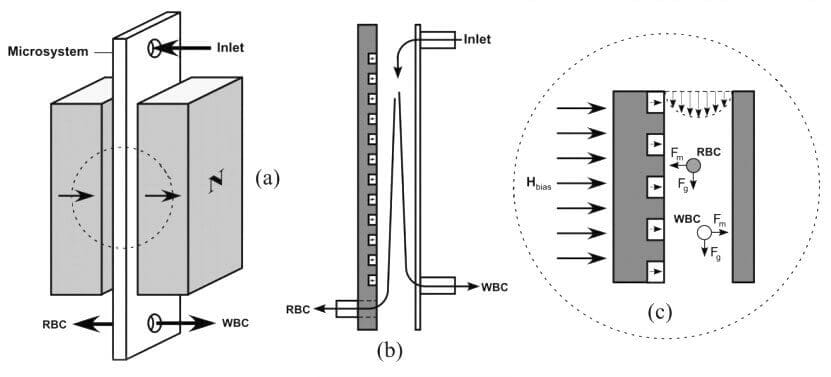
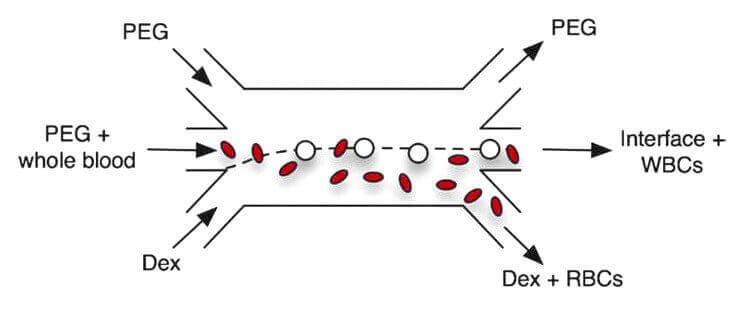
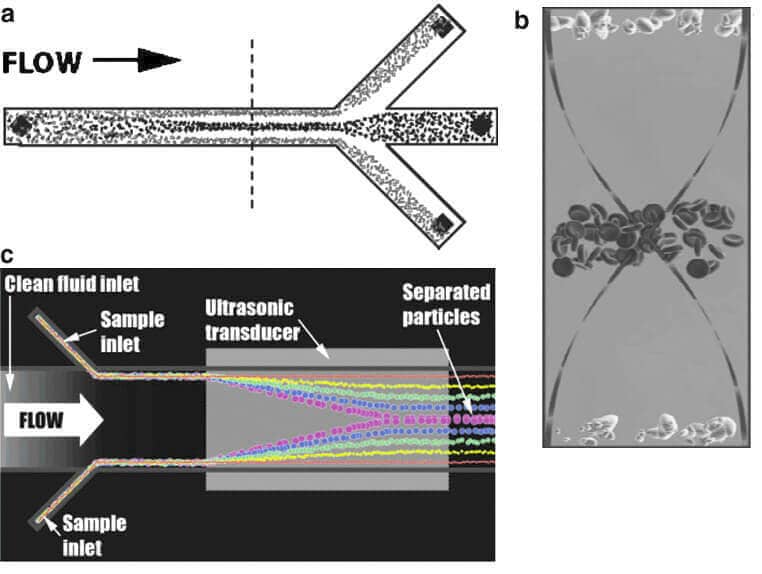
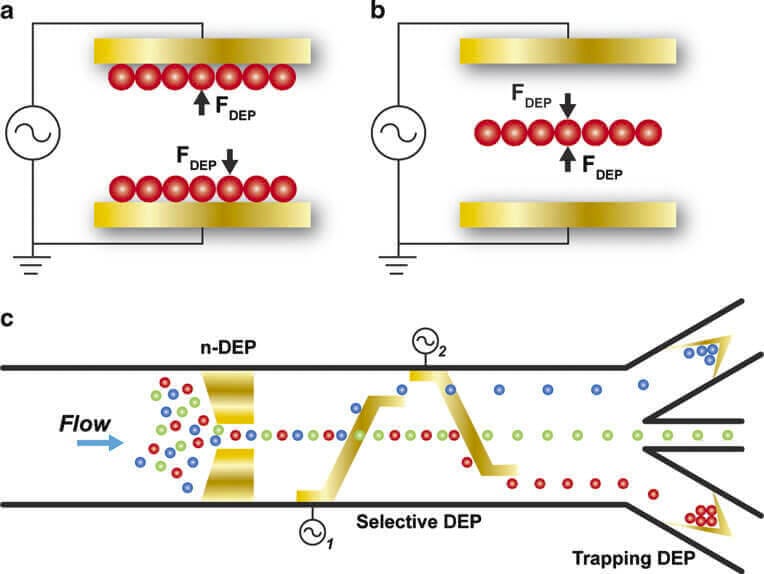

 Job
Job Collaborations
Collaborations Customer
Customer Other
Other